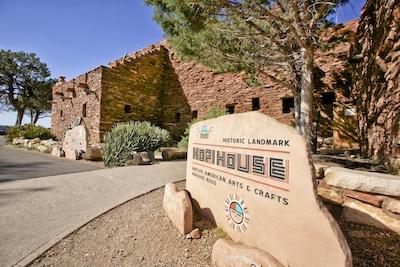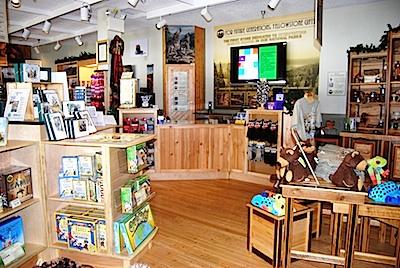
Native American artworks can be found, along with other made-in-America items, at Grand Canyon gift shops/Xanterra Parks & Resorts
Next time you find yourself in a gift shop at a national park, check out where the items were made. You just might be surprised that a majority of the items are made in America, with fewer and fewer bearing an oval gold-and-black 'Made in China' sticker on them.
That's because national park concessionaires continuously make an effort to focus on bringing more made-in-America products into their gift shops. And while they're making progress, they at times encounter barriers that make those strides difficult.
Companies such as Delaware North Companies Parks & Resorts, Aramark Leisure, and Xanterra Parks & Resorts, which oversee numerous attractions within many popular national park destinations, are quite familiar with the push for made-in-America merchandise. From lodging to retail shops, food and beverage and recreational services, they see a alot of foot traffic in our parks from visitors from around the globe, who want to pick up a souvenir or two. So how does it affect the big buyers for national park retail shops?
Though claiming manufacture origin seems black-and-white, American-made or not, there are many more elements at play in accurately defining whether a product is 100 percent made in America. In a recent interview with the Traveler, Donna Genesky, vice president of retail for Delaware North, explained what constitutes American-made merchandising.
'There are different types, or categories, of made in America. We run between 40-45 percent all made-in-America products, manufactured here in the U.S.,' Ms. Genesky said. 'Those products we promote accordingly with signage, marketing, and having our product specialists speak to them. Additionally, we have another 20-25 percent that are goods decorated here. Good examples of those items are mugs and T-shirts ' blank products brought into the states and then designed, painted, printed or otherwise decorated here. That now brings us up closer to 60-65 percent of our goods that are either made in America, or finished here in America.'
Ms. Genesky noted that Delaware North is always seeking American-made goods, and keeps that inmind when attending retail shows, where they search for new vendors. Local-level buying is of utmost importance when catering to national park visitors. The Delaware North team seeks out handcrafted goods like jewelry, clay pottery, and other artisan items that represent a specific park and it's cultural place within the community. Providing authentic artisan options alongside the predictable stuffed animals and mugs allows them to reach out to all price ranges, ages and expectations.
Aramark seeks to have diverse price points and products on their shelves. Eric Flanigan, vice president of retail for all Aramark locations, stressed the importance of reaching out to local vendors. His retail team spends alot of time at tradeshows in major cities, where retailers from surrounding towns and attractions display their work. They try to incorporate the local trade into their retail services, just as Delaware North does when possible.
'This year we are strategically working on actively searching for locally made in USA products,' Mr. Flanigan said. 'We buy local to represent our buyers and their needs. Our asset, and what makes us important, is that we have people on the ground looking for local vendors constantly.'
Those efforts, overall, succeed fairly well, though their ultimate success stocking made-in-America items depends on which products are available in the area. For example, 75 percent of the merchandize at Aramark's gift shops at Glen Ganyon National Recreation Area is made in the United States, while 72 percent of the items at the company's outlets at Denali National Park and Preserve are made in the United States.
Both Aramark and Delaware North run into complications for 100 percent American-made apparel, plush products, and mugs. Most of these products are designed in the states by teams of graphic designers, stitched and constructed abroad, and then brought back to the United States for finishing touches. Souvenir mugs and T-shirts are prime examples of this back-and-forth process.

Seventy-five percent of the items Aramark stocks its Glen Canyon NRA gift shops are made in America/Aramark Leisure
Alongside Delaware North and Aramark, Xanterra is another hospitality management company with lodges, restaurants, and concessions in national parks, and they take pride in its made-in-America collection. In fact, when you stay in one of the lodges Xanterra runs you will find a small brochure that explains that in 2013, 68 percent of the retail items were made in America. Eric Robinson, the director of retail for Xanterra, with oversight of retail shops at Yellowstone and Glacier national parks, said the company has been "growing that number over the last 10 years. Just two years ago we were at 63 percent."
'For us, we qualify that as 100 percent made-in-America,' Mr. Robinson went on. 'Now, we do have additional products, and the percentage is pretty good. I think it's about 12-13 percent where the product will be labeled that it's made somewhere else but it's finished here in the United States. The biggest category for us would be apparel items. T-shirts might be cut and sewn in Guatemala, but the silkscreen process, all the art, takes place here in the United States.'
When asked about the price difference in products made abroad vs. those in the United States, he noted that, 'Each category is going to be a little bit different. You can find mugs domestically and they run 20-25 percent more than the things that come from overseas, so we have an offering of both that come in the mug categories.'
American-made goods usually have a heftier price tag because of their production costs. In the United States producers are held to labor laws and fair compensation rates, while offshore manufacturers have cheaper production costs that often come without labor guidelines. After talking to the retail buyers, it comes down to having a diverse range of prices and products to stock their shelves.
Mr. Robinson did say that the focus on made-in-America products has grown rapidly in the last five or six years.
'We've always been conscientious of it, but I'd say we paid even closer attention to it 5 or 6 years ago," he said, explaining that part of the motivation was, "feedback from the customers, from our guests," and some efforts in Congress to require national park gift shops to sell only made-in-America items.
Traveler has covered this subject, at times, in the past. Readers have contrasting opinions about requiring American-made goods in our national parks. Some view it as impractical, believeing that the price increase alone might, potentially, have visitors leaving gift shops empty-handed, leading to less employment in parks, and an unstable financial future. Others thought it would be difficult to accomplish, yet they favored a slow, but concerted, incorporation of American-made goods over time.

Gift shops in Yellowstone National Park are filled with almost 70 percent made-in-American merchandize/Xantarra Parks & Resorts
According to Congressman Steve Israel from New York, actively seeking out American-made commodities is of utmost importance to the health of the American manufacturing industry. In June 2013, the congressman sponsored his 'American Parks, American Products Act,' which would require national parks to sell merchandise strictly made in America.
Senator Kirsten Gillibrand, D-New York, introduced the legislation in her chamber, saying 'This is common sense legislation to ensure products sold at America's National Parks are made by our manufacturers and small businesses, proudly stamped with the words 'Made in America.' The celebration of our National Parks goes hand in hand with the pride of American-made products and our strong manufacturing tradition. The 'American Parks, American Products Act' has the potential to support manufacturing jobs, and showcase American craftsmanship.'
The legislation, if passed, would impact retail buyers from many organizations and businesses situated in, and around, national parks. With the legislation still in limbo, concessionaires continue to seek out cost-effective items manufactured stateside. Until the legislation advances, the consumer is tasked with choosing between foreign goods, partially made in America items, and those made in the USA.
The Outdoor Industry Association (OIA) and Outdoor Retailer (OR) created this Made in America Product Showcase, which premiered at the Outdoor Retailer Summer 2014 convention, which just concluded in Salt Lake City, Utah. It features over 30 products from American manufacturers to share the story of companies sourcing here in the United States.
Utah native Carli Jones grew up exploring the outdoors on family outings, weekend camping trips, and hiking in Zion and beyond. An editorial intern for the Traveler, she is a student at the University of Utah studying communication and nutrition. During her spare time she cycles, hikes, rock climbs and snowboards.

 Support Essential Coverage of Essential Places
Support Essential Coverage of Essential Places







Comments